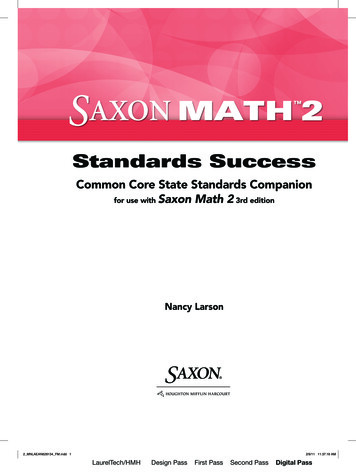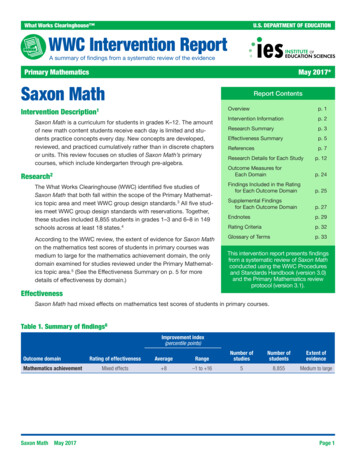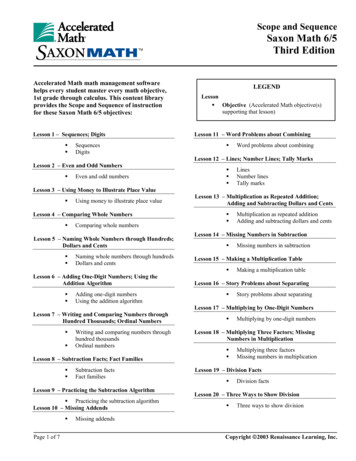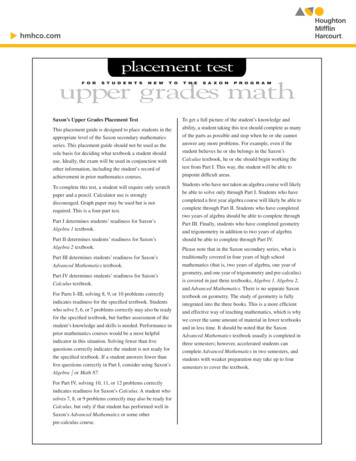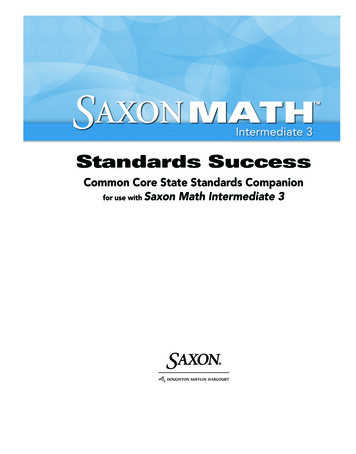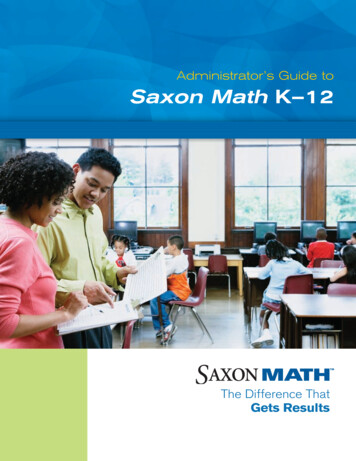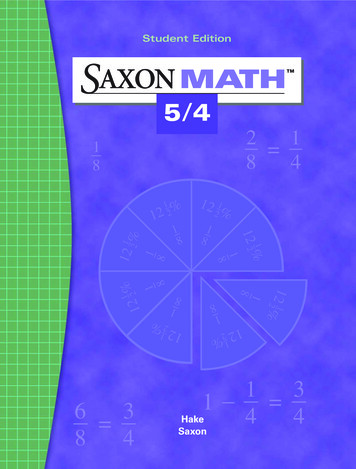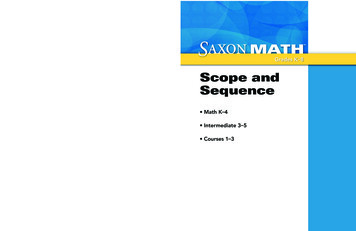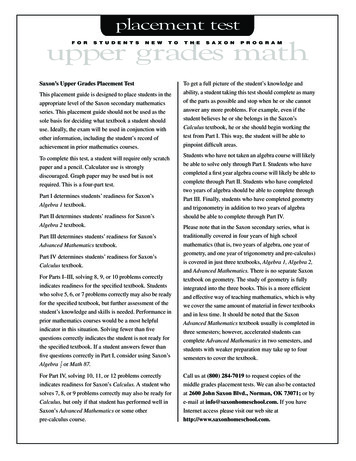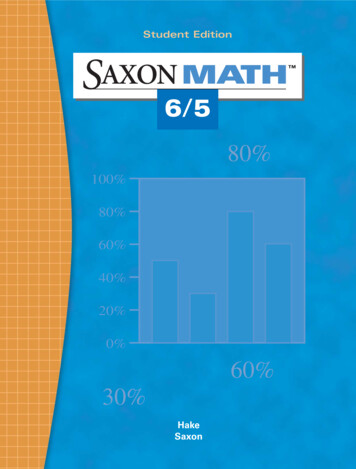
Transcription
Student EditionSAXON MATH 6/580%100%80%60%40%20%0%60%30%HakeSaxon
Student EditionStephen HakeJohn Saxon
Saxon Publishers gratefully acknowledges the contributions of the following individuals inthe completion of this project:Authors: Stephen Hake, John SaxonConsultants: Diane Blank, Shirley McQuade DavisEditorial: Chris Braun, Brian E. Rice, Mary Burleson, Sherri Little, Rodney Clint Keele,Bo Björn Johnson, Brian Smith, Brooke Butner, Andrew Kershen, Dana Nixon,Sean G. DouglasEditorial Support Services: Christopher Davey, Jay Allman, Jean Van Vleck, ShelleyTurner, Darlene C. TerryProduction: Adriana Maxwell, Karen Hammond, Brenda Lopez, Debra Sullivan, DianeReadnour, Donna Jarrel, Ryan LaCroix, Alicia Britt, Nancy Rimassa, Cristi D. WhiddonProject Management: Angela Johnson, Becky Cavnar 2004 Saxon Publishers, Inc., and Stephen HakeAll rights reserved. No part of Saxon Math 6/5, Third Edition, Student Edition maybe reproduced, stored in a retrieval system, or transmitted in any form or by any means,electronic, mechanical, photocopying, recording, or otherwise, without the prior writtenpermission of the publisher. Address inquiries to Editorial Support Services, SaxonPublishers, Inc., 2600 John Saxon Blvd., Norman, OK 73071.Printed in the United States of AmericaISBN: 1-56577-505-8Manufacturing Code: 02S0803
C O N T E N T SLetter from Author Stephen HakeAcknowledgmentsxixiiLESSON 1 Sequences Digits1LESSON 2 Even and Odd Numbers4LESSON 3 Using Money to Illustrate Place Value8LESSON 4 Comparing Whole Numbers12LESSON 5 Naming Whole Numbers Through Hundreds 16Dollars and CentsLESSON 6 Adding One-Digit Numbers 20Using the Addition AlgorithmLESSON 7 Writing and Comparing Numbers Through25Hundred Thousands Ordinal NumbersLESSON 8 Subtraction Facts Fact Families30LESSON 9 Practicing the Subtraction Algorithm34LESSON 10 Missing AddendsINVESTIGATION Story Problems39431LESSON 11 Story Problems About Combining46LESSON 12 Lines Number Lines Tally Marks52LESSON 13 Multiplication as Repeated Addition 58Adding and Subtracting Dollars and CentsLESSON 14 Missing Numbers in Subtraction62LESSON 15 Making a Multiplication Table67LESSON 16 Story Problems About Separating72LESSON 17 Multiplying by One-Digit Numbers77LESSON 18 Multiplying Three Factors 82Missing Numbers in MultiplicationLESSON 19 Division Facts87LESSON 20 Three Ways to Show Division91INVESTIGATION Fractions: Halves, Fourths, and Tenths962v
viSaxon Math 6 / 5LESSON 21 Problems About Equal Groups101LESSON 22 One-Digit Division with a Remainder 106Divisibility by 2, 5, and 10LESSON 23 Recognizing Halves111LESSON 24 Parentheses Associative Property115LESSON 25 Listing the Factors of Whole Numbers119LESSON 26 Division Algorithm123LESSON 27 Reading Scales128LESSON 28 Measuring Time132LESSON 29 Multiplying by Multiples of 10 and 100137LESSON 30 Interpreting Pictures of Fractions and Percents142INVESTIGATION Fractions: Thirds, Fifths, and Eighths1473LESSON 31 Pairs of Lines151LESSON 32 Angles Polygons155LESSON 33 Rounding Numbers Using a Number Line162LESSON 34 Division with Zeros in the Quotient166LESSON 35 Problems About Comparing 170Problems About Elapsed TimeLESSON 36 Classifying Triangles175LESSON 37 Drawing Pictures of Fractions180LESSON 38 Fractions and Mixed Numbers184on a Number LineLESSON 39 Comparing Fractions by Drawing Pictures189LESSON 40 Pictures of Mixed Numbers 193Writing Quotients as Mixed Numbers, Part 1INVESTIGATION Measuring Angles1984LESSON 41 Adding and Subtracting Fractions with202Common DenominatorsLESSON 42 Short Division Divisibility by 3, 6, and 9207LESSON 43 Writing Quotients as Mixed Numbers, Part 2 212Adding and Subtracting Whole Numbers,Fractions, and Mixed NumbersLESSON 44 Measuring Lengths with a Ruler217
ContentsLESSON 45 Classifying Quadrilaterals223LESSON 46 Stories About a Fraction of a Group230LESSON 47 Simplifying Mixed Measures234LESSON 48 Reading and Writing Whole Numbers238in Expanded NotationLESSON 49 Solving Two-Step Word Problems242LESSON 50 Finding an Average246INVESTIGATION Organizing and Analyzing Data2515LESSON 51 Multiplying by Two-Digit Numbers258LESSON 52 Naming Numbers Through Hundred Billions263LESSON 53 Perimeter Measures of a Circle268LESSON 54 Dividing by Multiples of 10273LESSON 55 Multiplying by Three-Digit Numbers277LESSON 56 Multiplying by Three-Digit Numbers280That Include ZeroLESSON 57 Simple Probability284LESSON 58 Writing Quotients as Mixed Numbers, Part 3289LESSON 59 Fractions Equal to 1 293Subtracting a Fraction from 1LESSON 60 Finding a Fraction to Complete a WholeINVESTIGATION Performing Probability Experiments2983026LESSON 61 Using Letters to Identify Geometric Figures307LESSON 62 Estimating Arithmetic Answers313LESSON 63 Subtracting a Fraction from a Whole317Number Greater than 1LESSON 64 Using Money to Model Decimal Numbers322LESSON 65 Decimal Parts of a Meter328LESSON 66 Reading a Centimeter Scale333LESSON 67 Writing Tenths and Hundredths as338Decimal NumbersLESSON 68 Naming Decimal Numbers344vii
viiiSaxon Math 6 / 5LESSON 69 Fractions of a Second 349Comparing and Ordering Decimal NumbersLESSON 70 Writing Equivalent Decimal Numbers 354Writing Cents CorrectlyINVESTIGATION Pattern Recognition3597LESSON 71 Fractions, Decimals, and Percents365LESSON 72 Area, Part 1371LESSON 73 Adding and Subtracting Decimal Numbers377LESSON 74 Converting Units of Length382LESSON 75 Changing Improper Fractions to386Whole or Mixed NumbersLESSON 76 Multiplying Fractions391LESSON 77 Converting Units of Weight and Mass397LESSON 78 Exponents and Powers401LESSON 79 Finding Equivalent Fractions by Multiplying by 1407LESSON 80 Prime and Composite Numbers412INVESTIGATION Displaying Data4178LESSON 81 Reducing Fractions, Part 1425LESSON 82 Greatest Common Factor (GCF)431LESSON 83 Properties of Geometric Solids435LESSON 84 Mean, Median, Mode, and Range439LESSON 85 Converting Units of Capacity444LESSON 86 Multiplying Fractions and Whole Numbers448LESSON 87 Using Manipulatives and453Sketches to Divide FractionsLESSON 88 Transformations458LESSON 89 Finding a Square Root463LESSON 90 Reducing Fractions, Part 2467INVESTIGATION Line Graphs4729LESSON 91 Simplifying Improper Fractions476LESSON 92 Dividing by Two-Digit Numbers481
ContentsLESSON 93 Comparative Bar Graphs486LESSON 94 Using Estimation When Dividing by490Two-Digit NumbersLESSON 95 Reciprocals494LESSON 96 Using Reciprocals to Divide Fractions499LESSON 97 Ratios504LESSON 98 Negative Numbers508LESSON 99 Adding and Subtracting Whole512Numbers and Decimal NumbersLESSON 100 Simplifying Decimal NumbersINVESTIGATION Graphing Points on a Coordinate Plane51752110LESSON 101 Rounding Mixed Numbers to the524Nearest Whole NumberLESSON 102 Subtracting Decimal Numbers Using Zeros528LESSON 103 Volume532LESSON 104 Rounding Decimal Numbers to the537Nearest Whole NumberLESSON 105 Symmetry542LESSON 106 Reading and Ordering Decimal Numbers548Through Ten-ThousandthsLESSON 107 Using Percent to Name Part of a Group554LESSON 108 Schedules559LESSON 109 Multiplying Decimal Numbers564LESSON 110 Multiplying Decimal Numbers:569Using Zeros as PlaceholdersINVESTIGATION Scale Drawings57311LESSON 111 Multiplying Decimal Numbers576by 10, by 100, and by 1000LESSON 112 Finding the Least Common580Multiple of Two NumbersLESSON 113 Writing Mixed Numbers as Improper Fractions584LESSON 114 Problems with No Solutions or Many Solutions589LESSON 115 Area, Part 2594ix
xSaxon Math 6 / 5LESSON 116 Finding Common Denominators to Add,598Subtract, and Compare FractionsLESSON 117 Dividing a Decimal Number by a Whole Number603LESSON 118 Using Zero as a Placeholder Dividing Decimal608Numbers by 10, by 100, and by 1000LESSON 119 Dividing by a Decimal Number613LESSON 120 Multiplying Mixed Numbers617INVESTIGATION Tessellations62112TOPIC A Roman Numerals Through 39629TOPIC B Roman Numerals Through Thousands631TOPIC C Base 5632Supplemental Practice Problems forSelected Lessons635Glossary665Index697
LETTER FROM AUTHOR STEPHEN HAKEDear Student,We study mathematics because of its importance to our lives. Ourschool schedule, our trip to the store, the preparation of our meals,and many of the games we play involve mathematics. You willfind that the word problems in this book are often drawn fromeveryday experiences.As you grow into adulthood, mathematics will become even moreimportant. In fact, your future in the adult world may depend onthe mathematics you have learned. This book was written to helpyou learn mathematics and to learn it well. For this to happen, youmust use the book properly. As you work through the pages, youwill see that similar problems are presented over and over again.Solving each problem day after day is the secret to success.Your book is made up of daily lessons and investigations. Eachlesson has four parts. The first part is a Warm-Up that includespractice of basic facts and mental math. These exercises improveyour speed, accuracy, and ability to do math “in your head.” TheWarm-Up also includes a problem-solving exercise to familiarizeyou with strategies for solving complicated problems. The secondpart of the lesson is the New Concept. This section introduces anew mathematical concept and presents examples that use theconcept. In the next section, the Lesson Practice, you have achance to solve problems involving the new concept. Theproblems are lettered a, b, c, and so on. The final part of the lessonis the Mixed Practice. This problem set reviews previously taughtconcepts and prepares you for concepts that will be taught in laterlessons. Solving these problems helps you remember skills andconcepts for a long time.Investigations are variations of the daily lesson. The investigationsin this book often involve activities that fill an entire class period.Investigations contain their own set of questions instead of aproblem set.Remember, solve every problem in every practice set, everyproblem set, and every investigation. Do not skip problems.With honest effort, you will experience success and truelearning that will stay with you and serve you well in the future.Stephen HakeTemple City, Californiaxi
ACKNOWLEDGMENTSI wish to acknowledge the following contributors to the revision of SaxonMath 5/4–8/7:Barbara Place, who conceived the project.Dr. Gerald Beer, who provided lesson content and problems on topics ofpattern recognition, functions, scale drawings and models, probability, dataanalysis, and problem solving.Shirley McQuade Davis, for her ideas on teaching story-problem thinkingpatterns.Brian Rice, for his conceptual work on story-problem lessons and for hiseditorial work on the Assessments and Classroom Masters.Dan Shippey, who designed the Mercury Freedom 7 scale model for SaxonMath 7/6, Investigation 11.Mary Burleson, who scheduled the project and coordinated efforts among themany participants.Adriana Maxwell, who coordinated the production of the manuscripts.Diane Blank, for her extensive and thorough analysis of state standards andnumerous helpful suggestions for addressing those standards.Nancy Crisler, for her contributions to the Teacher’s Manuals.Nancy Larson, for her generous help and insightful suggestions for theTeacher’s Manuals.Chris Braun, whose invaluable contributions as senior editor span the contentsof the series.John Saxon, whose unwavering focus on student success continues to inspireand guide.Mary Hake, for her support, encouragement, and patience.Stephen HakeTemple City, Californiaxii
L E S S O N1Sequences DigitsWARM-UPFacts Practice: 100 Addition Facts (Test A)†Mental Math: Count by tens from 10 to 100. Count by hundredsfrom 100 to 1000.a. 3 3d. 40 50g. 20 20 20c. 300 300b. 30 30f. 50 50e. 200 600h. 500 500 500Problem Solving:The counting numbers are 1, 2, 3, 4, and so on. How many onedigit counting numbers are there?NEW CONCEPTSSequences Counting is a math skill that we learn early in life. Countingby ones, we say the numbers †1, 2, 3, 4, 5, 6, These numbers are called counting numbers. We can alsocount by a number other than one. Below we show the firstfive numbers for counting by twos and the first five numbersfor counting by fives.2, 4, 6, 8, 10, 5, 10, 15, 20, 25, An ordered list of numbers forms a sequence. Each memberof the sequence is a term. The three dots mean that thesequence continues even though the numbers are not written.We can study a sequence to discover its counting pattern, orrule. The rule can be used to find more terms in the sequence.Example 1 What are the next three terms in this counting sequence?3, 6, 9, 12, , , , †For instructions on how to use the Warm-up activities, please consult thepreface.1
2Saxon Math 6/5Solution The pattern is “Count up by threes.” To find the next threeterms, we may count up by threes, or we may count up byones and emphasize every third term (one, two, three, four,five, six, ). Either way, we find that the next three terms are15, 18, and 21.Example 2 Describe the rule for this counting sequence. What is the nextterm in the sequence?56, 49, 42, , Solution This sequence counts down. We find that the rule for thissequence is “Count down by sevens.” Counting down byseven from 42 gives us 35.Digits There are ten digits in our number system. They are 0, 1, 2, 3,4, 5, 6, 7, 8, and 9. The number 385 has three digits, and thelast digit is 5. The number 148,567,896,094 has twelve digits,and the last digit is 4.Example 3 The number 186,000 has how many digits?Solution The number 186,000 has six digits.Example 4 What is the last digit of 26,348?Solution The number 26,348 has five digits. The last digit is 8.LESSON PRACTICEPractice set Describe the rule for each counting sequence. Then write thenext three terms in the sequence.a. 6, 8, 10, , , , b. 7, 14, 21, , , , c. 4, 8, 12, , , , d. 21, 18, 15, , , , e. 45, 40, 35, , , , f. 12, 18, 24, , , ,
Lesson 13How many digits are in each of these numbers?g. 36,756h. 8002i. 1,287,495What is the last digit of each of these numbers?j. 17k. 3586l. 654,321MIXED PRACTICEProblem set Write the next term in each counting sequence:1. 10, 15, 20, , 2. 56, 49, 42, , 3. 8, 16, 24, , 4. 18, 27, 36, 45, , 5. 24, 21, 18, , 6. 32, 28, 24, 20, , Write the missing term in each counting sequence:7. 7, 14, , 28, 35, 8. 40, , 30, 25, 20, 9. 20, , 28, 32, 36, 11. , 36, 30, 24, 10. 24, 32, , 48, 12. 21, 28, , 42, Describe the rule for each counting sequence, and write thenext three terms:13. 3, 6, 9, 12, , , , 14. 8, 16, 24, , , , 15. 6, 12, 18, , , , 16. 40, 35, 30, , , , 17. 18, 21, 24, , , , 18. 9, 18, 27, , , , 19. What word names an ordered list of numbers?How many digits are in each number?20. 186,00021. 73,84222. 30,004,091What is the last digit of each number?23. 26,34824. 34725. 9,675,420
4Saxon Math 6/5L E S S O N2Even and Odd NumbersWARM-UPFacts Practice: 100 Addition Facts (Test A)Mental Math: Count up and down by tens between 10 and 100. Countup and down by hundreds between 100 and 1000.c. 600 600b. 60 60f. 300 300 300e. 70 80h. 50 50 50 50a. 6 6d. 60 70g. 90 90Problem Solving:How many two-digit counting numbers are there?NEW CONCEPTWhole numbers are the counting numbers and the number 0.0, 1, 2, 3, 4, 5, 6, Counting by twos, we say the numbers2, 4, 6, 8, 10, 12, 14, 16, 18, 20, This is a special sequence. These numbers are even numbers.The number 0 is also an even number. The sequence of evennumbers continues without end. The numbers 36 and 756 and148,567,896,094 are all even. We can tell whether a wholenumber is even by looking at the last digit of the number. Ifthe last digit is even, then the number is even. So evennumbers end with 0, 2, 4, 6, or 8.An even number of objects can be arranged in pairs. Twelve isan even number. Here we show 12 dots arranged in six pairs.Notice that every dot has a partner.Next we show 13 dots arranged in pairs. We find that there isa dot that does not have a partner. So 13 is not even.
Lesson 25The whole numbers that are not even are odd. We can makea list of odd numbers by counting up by twos from thenumber 1. Odd numbers form this sequence:1, 3, 5, 7, 9, 11, 13, 15, 17, If the last digit of a number is 1, 3, 5, 7, or 9, then the numberis odd. All whole numbers are either odd or even.Example 1 Which of these numbers is even?358623452223Solution Even numbers are the numbers we say when counting bytwos. We can see whether a number is odd or even by lookingat the last digit of the number. If the last digit is even, thenthe number is even. The last digits of these three numbers are6, 5, and 3, respectively. Since 6 is even and 5 and 3 are not,the only even number in the list is 3586.Example 2 Which of these numbers is not odd?123,456654,321353,535Solution All whole numbers are either odd or even. A number that isnot odd is even. The last digits of these numbers are 6, 1, and 5,respectively. Since 6 is even (not odd), the number that is notodd is 123,456.Half of an even number is a whole number. We know thisbecause an even number of objects can be separated into twoequal groups. However, half of an odd number is not a wholenumber. If an odd number of objects is divided into two equalgroups, then one of the objects will be broken in half. Thesetwo stories illustrate dividing an even number in half anddividing an odd number in half:Sherry has 6 cookies to share with Leticia. IfSherry shares the cookies equally, each girlwill have 3 cookies.Herman has 5 cookies to share with Ivan. IfHerman shares the cookies equally, each boywill have 2A cookies.
6Saxon Math 6/5Activity: HalvesThe table below lists the counting numbers 1 through 10.Below each counting number we have recorded half of thenumber. Continue the list of counting numbers and theirhalves for the numbers 11 through 20.Counting number12345678910Half of numberA11A22A33A44A5LESSON PRACTICEPractice set Describe each number as odd or even:a. 0b. 1234c. 20,001d. 999e. 3000f. 391,048g. All the students in the class separated into two groups.The same number of students were in each group. Wasthe number of students in the class an odd number or aneven number?h. Leticia has seven cookies to share with Willis. If Leticiashares the cookies equally, how many cookies will eachperson have?MIXED PRACTICEProblem set†1. If a whole number is not even, then what is it?(2)What is the last digit of each number?3. 296,3172. 47,286,560(1)(1)Describe each number as odd or even:5. 1964. 15(2)(2)6. 3567(2)7. Which of these numbers is even?(2)3716234522238. Which of these numbers is odd?(2)†45,67856,78967,890The italicized numbers within parentheses underneath each problem numberare called lesson reference numbers. These numbers refer to the lesson(s) inwhich the major concept of that particular problem is introduced. If additionalassistance is needed, refer to the discussion, examples, or practice problems ofthat lesson.
Lesson 279. Which of these numbers is not odd?(2)333,456654,321353,53510. Which of these numbers is not even?(2)300232323Write the next three terms in each counting sequence:11. 9, 12, 15, , , , (1)12. 16, 24, 32, , , , (1)13. 120, 110, 100, , , , (1)14. 28, 24, 20, , , , (1)15. 55, 50, 45, , , , (1)16. 18, 27, 36, , , , (1)17. 36, 33, 30, , , , (1)18. 18, 24, 30, , , , (1)19. 14, 21, 28, , , , (1)20. 66, 60, 54, , , , (1)21. 48, 44, 40, , , , (1)22. 99, 90, 81, , , , (1)23. 88, 80, 72, , , , (1)24. 84, 77, 70, , , , (1)25. All the students in the class formed two lines. An equal(2)number of students were in each line. Which of thefollowing could not be the total number of students inthe class?A. 30B. 31C. 3226. What number is half of 5?(2)27. Which of these numbers is a whole number?(2)A. half of 11B. half of 12C. half of 13
8Saxon Math 6/5L E S S O N3Using Money toIllustrate Place ValueWARM-UPFacts Practice: 100 Addition Facts (Test A)Mental Math: Count up and down by tens between 10 and 200. Countup and down by hundreds between 100 and 2000.a. 30 70d. 340 200g. 120 60b. 20 300e. 250 40h. 600 120c. 320 20f. 250 400Problem Solving:How many three-digit counting numbers are there?NEW CONCEPTActivity: Place ValueMaterials needed: Activity Masters 1, 2, and 3 (two copies of each masterper student; masters available in Saxon Math 6/5Assessments and Classroom Masters) Activity Master 4 (one copy per student) locking plastic bags (one per student) paper clips (three per student)Preparation:Step 1: Cut out the 1, 10, and 100 money manipulativeson Activity Masters 1–3. A paper cutter, if available,will save time.Step 2: Distribute the money manipulatives, copies ofActivity Master 4 (Place-Value Template), bags, andpaper clips to students.Note: At the end of this lesson students may store theirmoney manipulatives in the plastic bags, clippingtogether bills of the same denomination. This papermoney will be useful in later lessons.
Lesson 39Place twelve 1 bills on the template in the ones position, asshown below.PLACE-VALUE TEMPLATEhundredstensWe can use fewer bills to represent 12 by exchanging ten 1 bills for one 10 bill. Remove ten 1 bills from thetemplate, and replace them with one 10 bill in the tensposition. You will get this arrangement of bills:PLACE-VALUE TEMPLATEhundredsThe bills on the template illustrate the expanded form of thenumber 12.Expanded form: 1 ten 2 onesNow place 312 on the place-value template, using the fewestbills necessary. Use the bills to write 312 in expanded form.PLACE-VALUE TEMPLATEFrom the template we see that the expanded form for 312 is3 hundreds 1 ten 2 ones
10Saxon Math 6/5Use the bills and place-value template to work these exercises:1. Place twelve 10 bills on the place-value template. Thenexchange ten of the bills for one 100 bill. Write theresult in expanded form.2. Place twelve 1 bills and twelve 10 bills on thetemplate. Then exchange bills to show that amount ofmoney using the least number of bills possible. Write theresult in expanded form.LESSON PRACTICEPractice seta. Which digit in 365 shows the number of tens?b. Use digits to write the number for “3 hundreds plus 5 tens.”c. How much money is one 100 bill plus ten 10 billsplus fifteen 1 bills? You may use your bills to help findthe answer.MIXED PRACTICEProblem set1. Use digits to write the number for “5 hundreds plus 7 tens(3)plus 8 ones.”2. Use digits to write the number for “2 hundreds plus 5 tens(3)plus 0 ones.”3. In 560, which digit shows the number of tens?(3)4. In 365, which digit shows the number of ones?(3)5. Ten 10 bills have the same value as one of what kind(3)of bill?6. Which of these numbers is not odd?(2)A. 365B. 653C. 5367. Which of these numbers is not even?(2)A. 1234B. 2345C. 34568. The greatest two-digit odd number is 99. What is the(2)greatest two-digit even number?9. Two teams have an equal number of players. The total(2)number of players on both teams could not beA. 22B. 25C. 50
Lesson 31110. We can count to 12 by 2’s or by 3’s. We do not count to 12(1)when counting byA. 1’sB. 4’sC. 5’sD. 6’sWrite the next three terms in each counting sequence:11. 9, 12, 15, , , , (1)12. 54, 48, 42, , , , (1)13. 8, 16, 24, , , , (1)14. 80, 72, 64, , , , (1)15. 16, 20, 24, , , , (1)16. 40, 36, 32, , , , (1)Describe the rule for each counting sequence, and find thenext three terms:17. 27, 36, 45, , , , (1)18. 81, 72, 63, , , , (1)19. 10, 20, 30, , , , (1)20. 33, 30, 27, , , , (1)21. What number equals four tens?(3)22. What number equals five hundreds?(3)23. How much money is two 100 bills plus twelve 10 bills(3)plus fourteen 1 bills? You may use your bills to helpfind the answer.24. The number 80 means “eight tens.” The number 800(3)means eight what?25. The fifth term in the counting sequence below is 20.(1)What is the ninth term in this sequence?4, 8, 12, 16, 26. How much money is half of 10?(2)27. How much money is half of 5?(2)28. Is the greatest two-digit number an odd number or an(2)even number?
12Saxon Math 6/5L E S S O N4Comparing Whole NumbersWARM-UPFacts Practice: 100 Addition Facts (Test A)Mental Math: Count up and down by tens between 0 and 200. Countup and down by hundreds between 0 and 2000.a.c.e.g.300300300340 300 20 20350300 50 50600b.d.f.h.250320250240 5032060320Problem Solving:The two-digit counting numbers that contain the digits 1 and 2are 12 and 21. There are six three-digit counting numbers thatcontain the digits 1, 2, and 3. One of these numbers is 213.What are the other five numbers?NEW CONCEPTWhen we count from 1 to 10, we count in order of size fromleast to greatest.1, 2, 3, 4, 5, 6, 7, 8, 9, 10leastgreatestOf these numbers, the least is 1 and the greatest is 10. Sincethese numbers are arranged in order, we can easily see that 5is greater than 4 and that 5 is less than 6.We can use mathematical symbols to compare numbers.These symbols include the equal sign ( ) and the “greaterthan/less than” symbol ( or ).5 5 is read“Five is equal to five.”5 4 is read“Five is greater than four.”5 6 is read“Five is less than six.”When using a “greater than/less than” symbol to compare twonumbers, we place the symbol so that the smaller end pointsto the smaller number.
Lesson 413Example 1 Write the numbers 64, 46, and 54 in order from least togreatest.Solution “From least to greatest” means “from smallest to largest.” Wewrite the numbers in this order:46, 54, 64Example 2 Complete each comparison by replacing the circle with theproper comparison symbol:(a) 7À 7À 4(b) 6(c) 6À 8Solution When two numbers are equal, we show the comparison withan equal sign.(a) 7 7When two numbers are not equal, we place the greaterthan/less than symbol so that the smaller end points to thesmaller number.(b) 6 4(c) 6 8Example 3 Compare:(a) 373À 47(b) 373À 382Solution (a) When comparing whole numbers, we know that numberswith more digits are greater than numbers with fewer digits.373 47(b) When comparing whole numbers with the same numberof digits, we consider the value place by place. The digitsin the hundreds place are the same, but in the tens place 8is greater than 7. So we have the following:373 382Example 4 Use digits and a comparison symbol to write this comparison:Six is less than ten.Solution We translate the words into digits. The comparison symbolfor “is less than” is “ ”.6 10
14Saxon Math 6/5LESSON PRACTICEPractice seta. Write the numbers 324, 243, and 423 in order from leastto greatest.Complete each comparison by replacing the circle with theproper comparison symbol:b. 36À 632c. 110À 101d. 90À 90e. 112À 121Write each comparison using mathematical symbols:f. Twenty is less than thirty.g. Twelve is greater than eight.MIXED PRACTICEProblem set Write each comparison using digits and a comparison symbol:1. Four is less than ten.(4)2. Fifteen is greater than twelve.(4)Complete each comparison by replacing the circle with theproper comparison symbol:3. 97À 1014. 34(4)À 43(4)5. Use digits to write the number for “3 hundreds plus 6 tens(3)plus 5 ones.”6. Which digit in 675 shows the number of hundreds?(3)7. Which digit in 983 shows the number of ones?(3)8. One 100 bill equals ten of what kind of bill?(3)Describe each number as odd or even:9. 36,275(2)10. 36,300(2)11. 5,396,428(2)12. The greatest two-digit odd number is 99. What is the(2)greatest three-digit odd number?
Lesson 41513. We can count to 18 by 2’s or by 3’s. We do not count to 18(1)when counting byA. 1’sB. 4’sC. 6’sD. 9’s14. Write the numbers 435, 354, and 543 in order from least(4)to greatest.15. The fourth term in the counting sequence below is 24.(1)What is the ninth term in this sequence?6, 12, 18, 16. What is the value of five 100 bills, thirteen 10 bills, and(3)ten 1 bills? You may use your money manipulatives tohelp find the answer.Write the next three terms in each counting sequence:17. 20, 24, 28, , , , (1)18. 106, 104, 102, , , , (1)19. 0, 6, 12, , , , (1)20. 0, 7, 14, , , , (1)21. 40, 32, 24, , , , (1)22. 45, 36, 27, , , , (1)23. What number equals nine tens?(3)24. What number equals eleven tens?(3)25. What is the seventh term in this counting sequence?(1)8, 16, 24, 26. Is the eleventh term of this counting sequence odd or even?(1, 2)2, 4, 6, 8, 27. What number is half of 9?(2)28. In Room 12 there is one more boy than there are girls. Is(2)the number of students in Room 12 odd or even?
16Saxon Math 6/5L E S S O N5Naming Whole NumbersThrough Hundreds Dollars and CentsWARM-UPFacts Practice: 100 Addition Facts (Test A)Mental Math: Count up and down by tens between 0 and 200. Countup and down by hundreds between 0 and 2000.a.c.e.g.200350400640 60 300420320 40250b.d.f.h.20 600 30250 25030 330 100260 260Problem Solving:Write all the three-digit numbers that each have the digits 2,3, and 4.NEW CONCEPTSNamingwholenumbersthroughhundredsIf numbers are to be our “friends,” we should learn theirnames. Naming numbers is not difficult if we pay attention toplace values. In order to name larger numbers, we should firstbe able to name numbers that have three digits. Let’s considerthe number 365. Below we use expanded form to break thenumber into its parts. Then we show the name of each part.three hundreds six tens five ones“three hundred”“sixty”“five”We will u
Saxon Math 6/5 LESSON 21 Problems About Equal Groups 101 LESSON 22 One-Digit Division with a Remainder 106 Divisibility by 2, 5, and 10 LESSON 23 Recognizing Halves 111 LESSON 24 Parentheses Associative Property 115 LESSON 25 Listing the Factors of Whole Numbers 119 LESSON 26 Division
